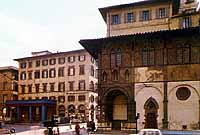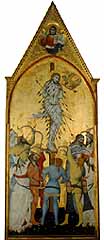
The Misericordia behind the Bigallo
The Archconfraternity of the Misericordia, previously the Company of Santa
Maria and earlier still the Militia of Santa Maria, was founded in the 13th
century, during the period of the really ferocious battles between the Guelphs
and Ghibellines for the control of the government of the Republic.
However its development was also linked to the battle of the Church against
the "Patarine"
heretics, who were instead supported by the Ghibellines to weaken
the papacy. The Dominican monk, St. Peter the
Martyr, founded the Militia of Santa Maria (1224) as a protection
against the Patarines.
Apart from its armed defence of the Faith, it soon found itself carrying out
other tasks, like assistance to the needy, burial of the poor and donations of
dowries to poor girls. The City Council of Florence raised the confraternity
to the rank of public board, with the power to elect its own Captains, on March
31st 1329. A group of auxilaries was created who had the exclusive task of the
transport of the sick, which they did using a "zane", a sort of stretcher
in the shape of a basket that was attached to the back with straps. The "zane"
was later abandoned for the "cataletto" or shoulder litter
which, in its turn, and for many centuries, made way for the hand
cart (the first ambulance car was to arrive in 1911). In the meantime
the Confraternity of the Misericordia built its headquarters (1352-58)
opposite the Baptistery, in the Loggia on
the corner between Piazza San Giovanni and Via
Calzaiuoli; it merged (1425) for a while with the Company of the
Bigallo until their separation in 1490. It also changed the colour
of its robes from red to black (1497) and set up its permanent headquarters
(1576) in a palace that was donated by the Grand Duke Francesco I
de' Medici and stood on the opposite corner of Via Calzaiuoli, facing Giotto's
Belltower.

St.Sebastian,
patron saint of the
Misericordia
The palace contains a great many works of art, among them a 13th century
Crucifix, a St. Sebastian and an unfinished Madonna (1495-97), carved by
Benedetto da Maiano. A painting by Pietro Annigoni can be seen on the exterior
facade. The patron saint of the confraternity, St. Sebastian (its other
patron saint is Tobias), is celebrated here on February 20th each year with
the distribution of blessed bread.
Even today the Archconfraternity of the Misericordia continues to give assistance
to the sick and needy and Florentine pride likes to think that this institution
later inspired Florence Nightingale (who was English but born in Florence) to
create the Red Cross.
